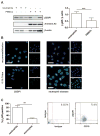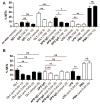Release of neutrophil extracellular traps by neutrophils stimulated with antiphospholipid antibodies: a newly identified mechanism of thrombosis in the antiphospholipid syndrome
- PMID: 26097119
- PMCID: PMC4626310
- DOI: 10.1002/art.39247
Release of neutrophil extracellular traps by neutrophils stimulated with antiphospholipid antibodies: a newly identified mechanism of thrombosis in the antiphospholipid syndrome
Abstract
Objective: Antiphospholipid antibodies (aPL), especially those targeting β2 -glycoprotein I (β2 GPI), are well known to activate endothelial cells, monocytes, and platelets, with prothrombotic implications. In contrast, the interaction of aPL with neutrophils has not been extensively studied. Neutrophil extracellular traps (NETs) have recently been recognized as an important activator of the coagulation cascade, as well as an integral component of arterial and venous thrombi. This study was undertaken to determine whether aPL activate neutrophils to release NETs, thereby predisposing to the arterial and venous thrombosis inherent in the antiphospholipid syndrome (APS).
Methods: Neutrophils, sera, and plasma were prepared from patients with primary APS (n = 52) or from healthy volunteers and characterized. No patient had concomitant systemic lupus erythematosus.
Results: Sera and plasma from patients with primary APS had elevated levels of both cell-free DNA and NETs, as compared to healthy volunteers. Freshly isolated neutrophils from patients with APS were predisposed to high levels of spontaneous NET release. Further, APS patient sera, as well as IgG purified from APS patients, stimulated NET release from control neutrophils. Human aPL monoclonal antibodies, especially those targeting β2 GPI, also enhanced NET release. The induction of APS NETs was abrogated with inhibitors of reactive oxygen species formation and Toll-like receptor 4 signaling. Highlighting the potential clinical relevance of these findings, APS NETs promoted thrombin generation.
Conclusion: Our findings indicate that NET release warrants further investigation as a novel therapeutic target in APS.
© 2015, American College of Rheumatology.
Conflict of interest statement
The authors have no competing interests or conflicts to disclose.
Figures






Comment in
-
Connective tissue diseases: Neutrophil extracellular traps--a mechanism of thrombosis in patients with antiphospholipid syndrome?Nat Rev Rheumatol. 2015 Aug;11(8):444. doi: 10.1038/nrrheum.2015.96. Epub 2015 Jul 7. Nat Rev Rheumatol. 2015. PMID: 26150123 No abstract available.
-
Reply.Arthritis Rheumatol. 2016 May;68(5):1321-2. doi: 10.1002/art.39579. Arthritis Rheumatol. 2016. PMID: 26748667 Free PMC article. No abstract available.
-
Low-Density Granulocytes Are Increased in Antiphospholipid Syndrome and Are Associated With Anti-β2 -Glycoprotein I Antibodies: Comment on the Article by Yalavarthi et al.Arthritis Rheumatol. 2016 May;68(5):1320-1. doi: 10.1002/art.39576. Arthritis Rheumatol. 2016. PMID: 26749538 No abstract available.
References
-
- Bertolaccini ML, Amengual O, Andreoli L, Atsumi T, Chighizola CB, Forastiero R, et al. Autoimmunity reviews; 14th International Congress on Antiphospholipid Antibodies Task Force. Report on antiphospholipid syndrome laboratory diagnostics and trends; 2014. - PubMed
-
- Hughes GR. Hughes’ syndrome: the antiphospholipid syndrome. A historical view. Lupus. 1998;7 (Suppl 2):S1–4. - PubMed
-
- Erkan D, Aguiar CL, Andrade D, Cohen H, Cuadrado MJ, Danowski A, et al. 14th International Congress on Antiphospholipid Antibodies: task force report on antiphospholipid syndrome treatment trends. Autoimmunity reviews. 2014;13(6):685–96. - PubMed
Publication types
MeSH terms
Substances
Grants and funding
LinkOut - more resources
Full Text Sources
Other Literature Sources
Medical
Miscellaneous

